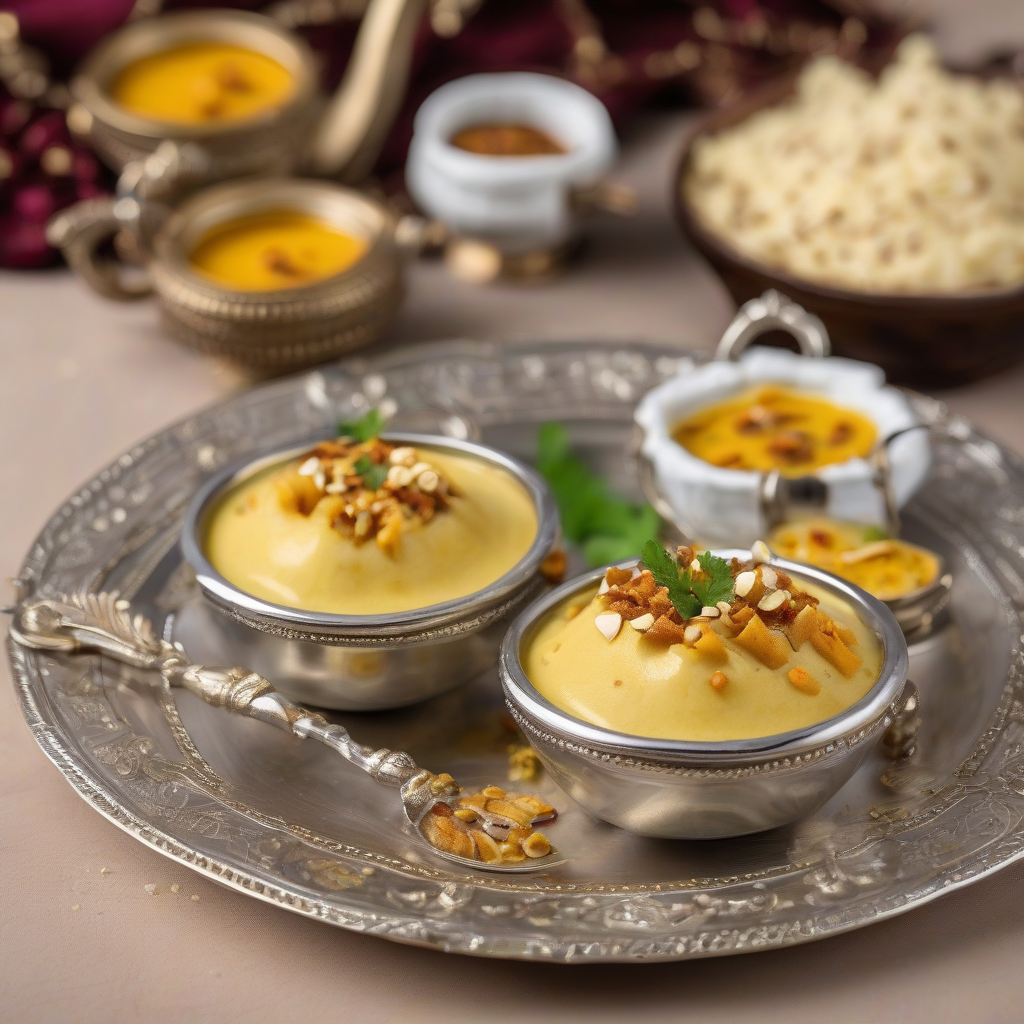Aye Hai! Rabdi Ghevar: The Sweet Symphony of Rajasthan in Your Kitchen!
Namaste, Kem Chho, and Sat Sri Akal, my foodie friends! Chef Curry Do’pyaza here, ready to whisk you away on a sweet journey to the heart of Rajasthan with a dessert fit for royalty: Rabdi Ghevar!
This honeycomb-shaped disc of deliciousness is more than just a sweet; it’s a celebration! You’ll find Ghevar gracing tables during Teej, Raksha Bandhan, and the vibrant monsoon season. It’s a symbol of prosperity, love, and the joyous spirit of Indian festivals. Imagine the pitter-patter of rain, the aroma of freshly fried Ghevar, and the laughter of loved ones – pure bliss, isn’t it?
A Royal Bite of History
Legend has it that Ghevar originated in Jaipur, Rajasthan, centuries ago. It was a favorite of the royal families, and its intricate design and rich flavor quickly made it a staple in Rajasthani cuisine. The word “Ghevar” is believed to be derived from “Ghee,” the clarified butter that is essential to its preparation. This sweet treat is a testament to the culinary artistry of our ancestors.
Let’s Get Cooking!
Preparation Time: 20 minutes
Cooking Time: 45 minutes
Ingredients:
- For the Ghevar:
- 1 cup Maida (All-Purpose Flour)
- 1/4 cup Ghee (Clarified Butter), melted
- 3 cups chilled Pani (Water)
- 5-6 cubes of Barf (Ice)
- 1/4 tsp Haldi (Turmeric Powder) – for color (optional)
- Ghee (Clarified Butter), for deep frying
- For the Sugar Syrup (Chashni):
- 1 cup Cheeni (Sugar)
- 1/2 cup Pani (Water)
- A pinch of Elaichi Powder (Cardamom Powder)
- For the Rabdi:
- 2 cups Doodh (Full-Fat Milk)
- 1/4 cup Cheeni (Sugar)
- A pinch of Kesar (Saffron) strands
- 1/4 tsp Elaichi Powder (Cardamom Powder)
- Chopped Pista (Pistachios) and Badam (Almonds) for garnish
Instructions:
- Making the Ghevar Batter: In a large bowl, mix the maida and melted ghee. Crumble the mixture with your fingers until it resembles breadcrumbs.
- Add ice cubes to the chilled water. Now, slowly add the chilled water to the maida mixture, a little at a time, whisking continuously to avoid lumps. The batter should be thin and flowing, like a watery buttermilk. Add the haldi if you are using it.
- Frying the Ghevar: Heat ghee in a deep, heavy-bottomed kadhai (wok) over medium heat. The ghee should be hot but not smoking.
- Pour a thin stream of batter from a height of about 10-12 inches into the center of the hot ghee. The batter will sizzle and spread out, forming a lacy disc.
- Continue pouring batter in the center of the disc, creating layers. Use a skewer or thin metal rod to make a hole in the center of the Ghevar.
- Fry the Ghevar until it turns golden brown and crispy on both sides. This will take about 5-7 minutes per Ghevar.
- Carefully remove the Ghevar from the ghee using a skewer and place it on a wire rack to drain excess ghee.
- Making the Sugar Syrup: In a saucepan, combine sugar and water. Bring to a boil and simmer until the syrup reaches a one-string consistency (when a drop of syrup between your fingers forms a single, thin string). Add cardamom powder and mix well.
- Making the Rabdi: In a heavy-bottomed pan, simmer milk over low heat, stirring occasionally, until it reduces to about half its original volume. This will take about 30-40 minutes.
- Add sugar, saffron strands, and cardamom powder. Continue to simmer for another 5-10 minutes, stirring continuously, until the rabdi thickens slightly.
- Assembling the Rabdi Ghevar: Dip the fried Ghevar in the warm sugar syrup for a few seconds, ensuring it’s evenly coated. Place the Ghevar on a serving plate.
- Generously spread the prepared rabdi over the Ghevar. Garnish with chopped pistachios and almonds.
Chef Curry’s Tips for a Perfect Ghevar
- Batter Consistency: The batter is key! It should be thin and flowing, like watery buttermilk. This will ensure a lacy and crispy Ghevar.
- Ghee Temperature: The ghee must be hot enough to sizzle the batter immediately, but not so hot that it burns it. Medium heat is ideal.
- Patience is a Virtue: Frying the Ghevar takes time. Be patient and allow it to turn golden brown and crispy on both sides.
- Freshness is Key: Serve the Rabdi Ghevar fresh for the best taste and texture.
Ghevar Your Way: Cooking Variations
While traditionally deep-fried, here are some adaptations:
- Gas Stove: Follow the instructions above for deep frying in a Kadhai.
- Induction Stove: Use a heavy-bottomed pan suitable for induction cooking and follow the deep-frying instructions.
- Air Fryer (for a healthier option): While not traditional, you can try baking the Ghevar in an air fryer after lightly brushing it with ghee. It won’t be the same, but it’s a healthier alternative. Experiment with temperature and time settings.
- Microwave: This method is not recommended for making Ghevar.
Nutritional Information (per serving, approximate)
- Calories: 450-550
- Fat: 25-35g
- Carbohydrates: 50-60g
- Protein: 8-10g
Note: Nutritional information is an estimate and may vary based on specific ingredients and portion sizes.
Serving Suggestions
Serve Rabdi Ghevar chilled or at room temperature. It’s a delightful dessert on its own, but you can also pair it with a scoop of vanilla ice cream for an extra indulgent treat.
Your Turn to Shine!
So there you have it, folks! My recipe for the incredibly delicious Rabdi Ghevar. It might seem a bit daunting, but trust me, with a little patience and love, you can create this magical sweet in your own kitchen.
Go ahead, give it a try! Prepare this for your family, friends and enjoy the sweet symphony of Rajasthan!
